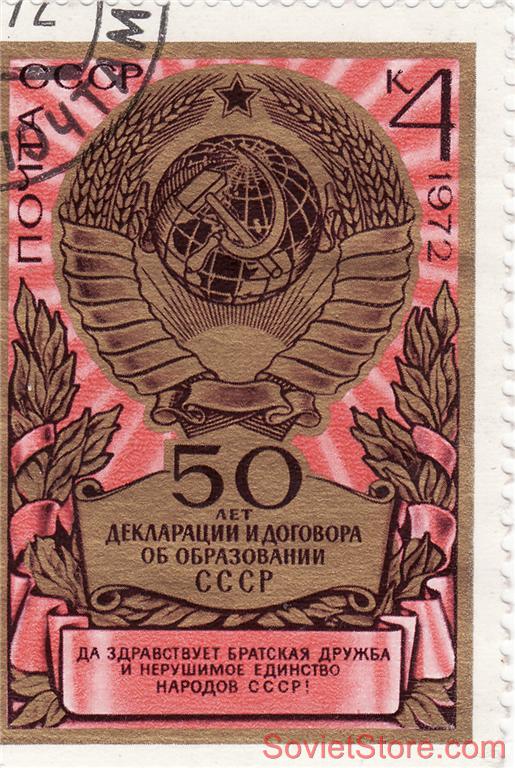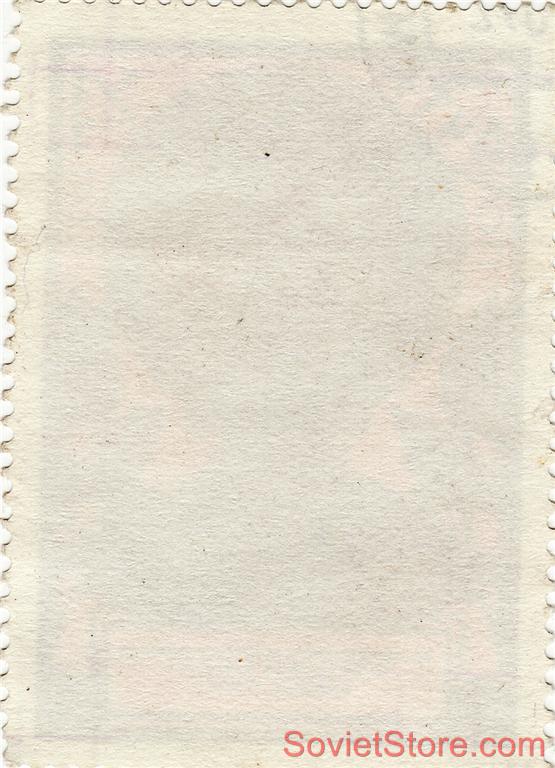SearchProduct Type
|
Add us to: Favorite Stores Item's weight: less then 1 g.
Stamp Authenticity Since 1939 till 1990 Lithuania suffered 3 occupations: 1 German (1941-1944) and 2 Soviet (1939-1941, 1944-1990), one of which lasted 46 years. In WWII occupations were based on violent battles between Germans and Russians. These historical events left a lot of stuff behind them selves. Almost every family in Lithuania has something left, related to USSR history in their forgotten drawers. So we are just traveling around lithuanian countrysides and collecting this memorabilia. Item is original, genuine, authentic, unique, not a copy or replica - has 2-12 decades of it's own unique history.
Soviet education was organized in a highly centralized government-run system. Its advantages were total access for all citizens and post-education employment. The Soviet Union recognized that the foundation of their system depended upon complete dedication of the people to the state through thorough psychological training as well as through military training, and through specialized education in the broad fields of engineering, the natural sciences, the life sciences and social sciences, along with education.
Pictures of the founder of the Soviet state, Vladimir Lenin, were often included in school textbooks. Above, he smiles in the background as the children argue over which direction of the classroom he is glancing at. Printed in the Armenian SSR.
In Imperial Russia, according to the 1897 Population Census, literate people made up 28.4 percent of the population. During the 8th Party Congress of 1919, the creation of the new Socialist system of education was proclaimed the major aim of the Soviet government. The abolition of illiteracy became the primary task in the Russian SFSR. In accordance with the Sovnarkom decree of December 26, 1919, signed by its head Vladimir Lenin, the new policy of likbez, was introduced. The new system of universal compulsory education was established for children. Millions of illiterate adult people all over the country, including residents of small towns and villages, were enrolled in special literacy schools. Komsomol members and Young Pioneer detachments played an important role in the education of illiterate people in villages. The most active phase of likbez lasted until 1939. In 1926, the literacy rate was 56.6 percent of the population. By 1937, according to census data, the literacy rate was 86% for men and 65% for women, making a total literacy rate of 75%. [1] An important aspect of the early campaign for literacy and education was the policy of "indigenization" (korenizatsiya). This policy, which lasted essentially from the mid-1920s to the late 1930s, promoted the development and use of non-Russian languages in the government, the media, and education. Intended to counter the historical practices of Russification, it had as another practical goal assuring native-language education as the quickest way to increase educational levels of future generations. A huge network of so-called "national schools" was established by the 1930s, and this network continued to grow in enrollments throughout the Soviet era. Language policy changed over time, perhaps marked first of all in the government's mandating in 1938 the teaching of Russian as a required subject of study in every non-Russian school, and then especially beginning in the latter 1950s a growing conversion of non-Russian schools to Russian as the main medium of instruction.[2] However, an important legacy of the native-language and bilingual education policies over the years was the nurturing of widespread literacy in dozens of languages of indigenous nationalities of the USSR, accompanied by widespread and growing bilingualism in which Russian was said to be the "language of internationality communication."[3] The worst feature of Soviet education in 1930s-1950s was its inflexibility and suppression. Under Joseph Stalin's rule many children, as young as twelve, whom were suspected of not embracing Soviet doctrine were murdered[4]. Research and education in the social sciences was dominated by Marxist-Leninist ideology and supervised by the CPSU. Such domination led to abolition of whole academic disciplines such as genetics.[5] Scholars were purged as they were proclaimed bourgeois and non-Marxist during that period. Most of the abolished branches were rehabilitated later in Soviet history, in the 1960s-1990s (e.g., genetics was in October 1964), although many purged scholars were rehabilitated only in post-Soviet times. In addition, many textbooks - such as history ones - were full of ideology and propaganda, and contained factually inaccurate information (see Soviet historiography).[6] Another aspect of the inflexibility was the high rate at which pupils were held back and required to repeat a year of school. In the early 1950s, typically 8-10% of pupils in elementary grades were held back a year. This was partly attributable to the pedagogical style of teachers, and partly to the fact that many of these children had disabilities that impeded their performance. In the latter 1950s, however, the Ministry of Education began to promote the creation of a wide variety of special schools (or "auxiliary schools") for children with physical or mental handicaps.[7] Once those children were taken out of the mainstream (general) schools, and once teachers began to be held accountable for the repeat rates of their pupils, the rates fell sharply. By the mid-1960s the repeat rates in the general primary schools declined to about 2%, and by the late 1970s to less than 1%.[8] The number of schoolchildren enrolled in special schools grew five-fold between 1960 and 1980. However, the availability of such special schools varied greatly from one republic to another. On a per capita basis, such special schools were most available in the Baltic republics, and least in the Central Asian ones. This difference probably had more to do with the availability of resources than with the relative need for the services by children in the two regions.[9] In the 1970s and 1980s, the Soviet people were about 99.7% literate. Classification and termsThe Soviet educational system was organized into three levels. The names of these levels were and are still used to rate the education standards of persons or particular schools, despite differences in the exact terminology used by each profession or school. Military, militsiya, KGB and Party schools were also graded according to these levels. This distinguishes Soviet system from the rest of the world, where educational levels of schools may differ, despite their similar names. Elementary schools were called the "beginning" level (Russian: начальное, nachalnoye), 4 and later 3 classes. Secondary schools were 7 and later 8 classes (required complete elementary school) and called "incomplete secondary education" (Russian: неполное среднее образование, nepolnoye sredneye obrazavanieh). This level was compulsory for all children (since 1958-1963) and optional for under-educated adults (who could study in so-called "evening schools"). Since 1981, the "complete secondary education" level (10 or, in some republics, 11 years) was compulsory. 10 classes (11 classes in the Baltic republics) of an ordinary school was called "secondary education" (Russian: среднее образование -- literally, "middle education"). PTUs, Tekhnikums, and some military facilities formed a system of so-called “secondary specialized education” (Russian: среднее специальное, sredneye spetsialnoye). PTU's were vocational schools and trained students in a wide variety of skills ranging from mechanic to hairdresser. Completion of a PTU after primary school did not provide a full secondary diploma or a route to such a diploma. However, entry to a tekhnikum or other specialized secondary school could be started after either 8 or 10 classes of combined education in elementary and secondary school. Graduation from this level was required for the positions of qualified workers, technicians and lower bureaucrats (see also vocational education, professions, training). “Higher” (Russian: высшее, vyssheye) educational institutions included degree-level facilities: universities, “institutes” and military academies. "Institute" in the sense of a school refers to a specialized "microuniversity" (mostly technical), usually subordinate to the ministry associated with their field of study. The largest network "institutes" were medical, pedagogic (for the training of schoolteachers), construction and various transport (automotive and road, railroad, civil aviation) institutes. Some of those institutes were present in every oblast' capital while others were unique and situated in big cities (like the Literature Institute and the Institute of Physics and Technics in Moscow). Colloquially these universities and institutes were all referred to by the acronym "VUZ" (ВУЗ – высшее учебное заведение, "higher educational institution"). Students who wanted admission to a VUZ had to have graduated from either a general secondary school (10 or 11 years) or a specialized secondary school or a tekhnikum. Those who completed only vocational school (PTU) or "incomplete secondary school" were not deemed to have been certified as having completed secondary education (they lacked an аттестат зрелости – maturity certificate – or equivalent diploma from a specialized secondary school) and were thus were not eligible to attend a VUZ. Numerous military and militsiya (police) schools (Russian: высшее училище/школа, vyshee uchilische/shkola) were on the same higher level. Note that Soviet military and militsiya facilities named "Academy" (Russian: Академия, Akademiya) were not a degree-level school (like Western military academies such as West Point), but a post-graduate school for experienced officers. Such schools were compulsory for officers applying for the rank of colonel, see Soviet military academies. KGB's higher education institutions were called either "schools" (like "Higher School of KGB") or "institutes" (like "Red Banner Institute of KGB" - training specifically intelligence officers). CPSU's higher education institutions were called "Higher Party Schools" (Russian: Высшая партийная школа, vysshaya partiynaya shkola). The spirit and structure of Soviet education is mostly inherited by many post-Soviet countries despite formal changes and social transitions. Citations
General references
The free listing tool. List your items fast and easy and manage your active items. On Jul-02-08 at 01:19:02 PDT, seller added the following information:
| Return
Items must be returned within 30 days .
Refund will be given as Money back. Refund policy details: Return is accepted at any reason. Item(s) must arrive to us not later then 30 days after it was shipped out (you will be informed about this immediately after it will be done). Returned items must be the same item in the exact same condition as originally shipped. Refunds are for the final eBay item purchase price only, less a 10% restocking fee. Shipping costs, insurance, and handling charges (if any) are non refundable. Returns must be shipped insured. Shipping
Payment Method
Insurance
Not Offered (Domestic)
|
Shopping Cart |
||||||||||||||||||||||||||||||||||||||||||||




